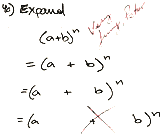Revolutionizing Calculation
The History of Logarithms
John Napier invented logarithms in the early 1600s. They were a major development in the abilities of computation, but this revolution did not just come out of nowhere.
Like all great inventions, there existed not only a need, but inspiration. Mathematicians of this time were mostly concerned with easing the complicated calculations of trigonometry, especially in astronomy and navigation. The method of prosthaphaeresis revolved around this formula:
sin(a) * sin (b) = [cos(a - b)-cos(a + b)]/2
This formula is just an identity that reduces a very difficult trig multiplication to simple additions, subtractions, and one division by 2. It is possible that it is this idea that inspired Napier to look for a similar method, one with applications beyond trigonometry. The logarithm was born!
Spreading the News
Napier first used the term artificial number, but he later decided on the word logarithm which comes from a Greek phrase meaning ratio number. He published the first table of answers to logarithms and introduced them to the world in 1614 in a small volume entitled Mirifici Logarithmorum Canonis Descriptio.
A Ripple of Excitement
The Descriptio excited many mathematicians of the time including Johann Kepler and Henry Briggs. Briggs assisted Napier in refining these tables, using the much simpler base of 10.
A Revolution
Using these tables, people could now do square roots and cube roots with ease. Hard multiplications and divisions could be changed into easy additions and subtractions.
By 1644, logarithms had spread to become a worldwide phenomenon. Explorers could now make quick calculations which allowed them to accurately navigate and also map out their discoveries like never before. Astronomers could now calculate planetary orbits that would have otherwise taken them years to do. The invention of the logarithm is considered by many to be the most influential leap in computation until perhaps the invention of the modern computer.
Napier's Bones
Napier also invented a device to do large multiplications and divisions easily by using printed rods and simple additions and subtractions. “Napier’s Bones,” as they are called, were extremely popular all over Europe in the 1600s.
They work much like the multiplication tables that many have us encountered in elementary school. In fact, they were still being used in elementary schools in Britain in the mid-1960s to help children learn multiplication.





